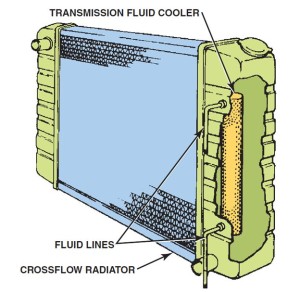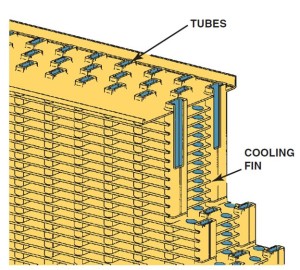Types of Radiator Cores
The two types of radiator cores in common use in most vehicles are:
- Serpentine fin core
- Plate fin core
In each of these types, the coolant flows through oval-shaped core tubes. Heat is transferred through the tube wall and soldered joint to cooling fins. The fins are exposed to the air that flows through the radiator, which removes heat from the radiator and carries it away.
Since the 1980s, most radiators have been made from aluminum with nylon-reinforced plastic side tanks. These materials are corrosion resistant, have good heat transferability, and are easily formed.
Core tubes are made from 0.0045 to 0.012 in. (0.1 to 0.3 mm) sheet brass or aluminum, using the thinnest possible materials for each application. The metal is rolled into round tubes and the joints are sealed with a locking seam.
The two basic designs of radiators include:
- Down-flow radiators. This design was used mostly in older vehicles, where the coolant entered the radiator at the top and flowed downward, exiting the radiator at the bottom.
- Cross-flow radiators. Most radiators use a cross-flow design, where the coolant flows from one side of the radiator to the opposite side.
How Radiators Work
The main limitation of heat transfer in a cooling system is in the transfer from the radiator to the air. Heat transfers from the water to the fins as much as seven times faster than heat transfers from the fins to the air, assuming equal surface exposure. The radiator must be capable of removing an amount of heat energy approximately equal to the heat energy of the power produced by the engine. Each horsepower is equivalent to 42 BTUs (10,800 calories) per minute. As the engine power is increased, the heat-removing requirement of the cooling system is also increased.
With a given frontal area, radiator capacity may be increased by increasing the core thickness, packing more material into the same volume, or both. The radiator capacity may also be increased by placing a shroud around the fan so that more air will be pulled through the radiator.
- NOTE: The lower air dam in the front of the vehicle is used to help direct the air through the radiator. If this air dam is broken or missing, the engine may overheat, especially during highway driving due to the reduced airflow through the radiator.
When a transmission oil cooler is used in the radiator, it is placed in the outlet tank, where the coolant has the lowest temperature.

Many vehicles equipped with an automatic transmission use a transmission fluid cooler installed in one of the radiator tanks.
Pressure Caps
Operation
On most radiators the filler neck is fitted with a pressure cap. The cap has a spring-loaded valve that closes the cooling system vent. This causes cooling pressure to build up to the pressure setting of the cap. At this point, the valve will release the excess pressure to prevent system damage. Engine cooling systems are pressurized to raise the boiling temperature of the coolant.
- The boiling temperature will increase by approximately 3°F (1.6°C) for each pound of increase in pressure.
- At sea level, water will boil at 212°F (100°C). With a 15 PSI (100 kPa) pressure cap, water will boil at 257°F (125°C), which is a maximum operating temperature for an engine.
Functions
The specified coolant system temperature serves two functions.
- It allows the engine to run at an efficient temperature, close to 200°F (93°C), with no danger of boiling the coolant.
- The higher the coolant temperature, the more heat the cooling system can transfer. The heat transferred by the cooling system is proportional to the temperature difference between the coolant and the outside air. This characteristic has led to the design of small, high-pressure radiators that are capable of handling large quantities of heat. For proper cooling, the system must have the right pressure cap correctly installed.
A vacuum valve is part of the pressure cap and is used to allow coolant to flow back into the radiator when the coolant cools down and contracts.
- NOTE: The proper operation of the pressure cap is especially important at high altitudes. The boiling point of water is lowered by about 1°F for every 550 ft increase in altitude. Therefore, in Denver, Colorado (altitude 5,280 ft), the boiling point of water is about 202°F, and at the top of Pike’s Peak in Colorado (14,110 ft) water boils at 186°F.
Metric Radiator Caps
According to the SAE Handbook, all radiator caps must indicate their nominal (normal) pressure rating. Most original equipment radiator caps are rated at about 14 to 16 PSI (97 to 110 kPa).

The pressure valve maintains the system pressure and allows excess pressure to vent. The vacuum valve allows coolant to return to the system from the recovery tank.
However, many vehicles manufactured in Japan or Europe use radiator pressure indicated in a unit called a bar. One bar is the pressure of the atmosphere at sea level, or about 14.7 PSI. The conversions can be used when replacing a radiator cap, to make certain it matches the pressure rating of the original.
- NOTE: Many radiator repair shops use a 7 PSI (0.5 bar) radiator cap on a repaired radiator. A 7 PSI cap can still provide boil protection of 21°F (3°F x 7 PSI = 21°F) above the boiling point of the coolant. For example, if the boiling point of the antifreeze coolant is 223°F, then 21°F is added for the pressure cap, and boilover will not occur until about 244°F (223°F + 21°F = 244°F). Even though this lower pressure radiator cap provides some protection and will also help protect the radiator repair, the coolant can still boil before the “hot” dash warning light comes on and, therefore, should not be used. In addition, the lower pressure in the cooling system could cause cavitation to occur and damage the water pump. For best results, always follow the vehicle manufacturer’s recommended radiator cap.
Working Better Under Pressure
A problem that sometimes occurs with a high-pressure cooling system involves the water pump. For the pump to function, the inlet side of the pump must have a lower pressure than its outlet side. If inlet pressure is lowered too much, the coolant at the pump inlet can boil, producing vapor. The pump will then spin the coolant vapors and not pump coolant. This condition is called pump cavitation. Therefore, a radiator cap could be the cause of an overheating problem. A pump will not pump enough coolant if not kept under the proper pressure for preventing vaporization of the coolant.
Next Steps towards ASE Certification
Now that you’re familiar with Radiators in Automotive Engines, try out our free Automotive Service Excellence Tests to see how much you know!
![ASE Certification Training HQ - Free ASE Practice Tests [Updated 2021]](https://asecertificationtraining.com/wp-content/themes/simplefolio/images/ASE Certification Logo.png)


